Comprehensive Guide to Inflatable Kite Wings
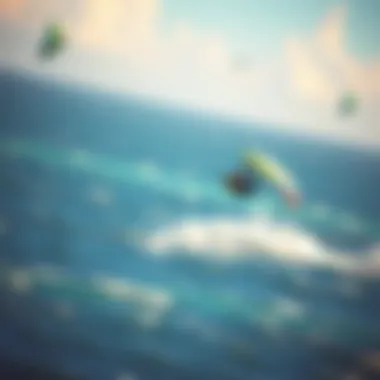
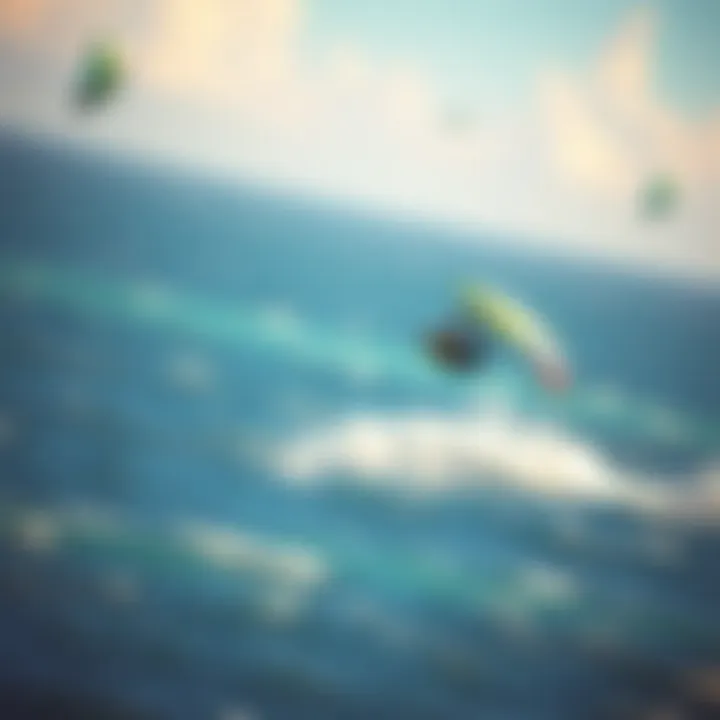
Intro
Inflatable kite wings have transformed the face of kiteboarding, creating a unique blend of excitement and performance for riders of all skill levels. Unlike traditional kites, these wings harness the power of lighter materials and advanced engineering, outperforming earlier designs and making kiteboarding more accessible. It’s not just about aesthetics; the innovation in inflatable kite wings represents a leap in how enthusiasts interact with wind and water.
As the sport evolves, understanding the intricacies of these wings becomes critical for both beginners and seasoned kiteboarders. In this guide, we’ll dive into various aspects, covering everything from equipment insights to advanced techniques, as well as how to choose, maintain, and optimize your inflatable kite wings. With a holistic approach, this resource seeks to illuminate the often nuanced world of kiteboarding, helping you navigate your way towards unforgettable adventures and improved performance on the water.
Understanding Inflatable Kite Wings
Inflatable kite wings have carved a niche in the kiteboarding realm, bringing precision and excitement into the sport. Understanding these wings is essential for anyone looking to ride the winds, whether you're a seasoned pro or just dipping your toes into the kiteboarding scene. With a good grasp on inflatable kite wings, riders can better appreciate the nuances of their performance, optimize their riding style, and make informed choices when selecting equipment.
Definition and Functionality
Inflatable kite wings are unique kites designed specifically for soaring across water surfaces, combining the features of traditional kites with innovative inflatable structures. These wings are designed to catch the wind, providing lift that propels riders forward. The heart of their design lies in a series of inflatable tubes that maintain shape and create a surface area for wind interaction. What sets them apart from other kites is their ability to deflate and pack down, making them portable and convenient for travel.
Moreover, the inflatables often share a common function: they harness wind energy not merely for elevation, but also for dynamic control over speed and direction. This capability allows riders to execute a range of maneuvers, from gentle gliding to thrilling jumps, tailoring their experience according to their skill set and the wind's temperament.
Preface to Kiteboarding
Kiteboarding, the sport that has emerged from the simple roots of kitesurfing, has evolved significantly over the years. At its core, kiteboarding involves riding on a board while being propelled by a kite, which is tethered to the rider through a harness. This combination creates a unique, exhilarating experience on the water, drawing adrenaline seekers from all walks of life.
The sport's appeal lies not only in the thrill but also in the connection it fosters with nature. Riders learn to read wind patterns, understand the water's behavior, and develop a sense of timing that is crucial for executing flawless moves. With inflatable kite wings, kiteboarding enthusiasts can expect to navigate through various conditions, enhancing their engagement with the elements.
It’s crucial to recognize that the journey into kiteboarding is laden with choices. Everything from the type of kite wing to the size and board design impacts one’s experience. As we’ll see later, inflated wings have revolutionized kiteboarding, offering advantages like versatility and stability that significantly enhance rider performance.
"Knowledge puts you in the driver’s seat. Understanding your gear, especially when it comes to kite wings, can make or break your ride."
Overall, understanding inflatable kite wings not only helps in selecting the right equipment but also deepens the rider's appreciation for the art and science behind kiteboarding.
The Evolution of Inflatable Kite Wings
The journey of inflatable kite wings represents a fascinating evolution in the realm of kiteboarding. By tracing this development, one can appreciate the blend of technological innovation and user-centric design that has shaped the sport today. Understanding how inflatable kite wings evolved offers insights into their functionality, efficiency, and performance. It also sheds light on the desires and needs of riders, which drove advancements in this niche of water sports.
Historical Development
Inflatable kites trace their lineage back to the historical use of kites for various purposes, from fishing to military signaling. However, the modern inflatable kite, specifically used in kiteboarding, started taking shape in the late 1980s.
In those early days, kite designs were quite rudimentary, primarily utilizing a simple structure without significant attention to aerodynamics or performance. The original kites were, let's be honest, more akin to oversized parachutes than the sleek machinery we see today. It wasn't until the incorporation of inflatable tubes that the kites began to significantly improve in stability and control.
The breakthrough came in the 1990s, when kiteboarding started to gain momentum. This period marked the introduction of designs that included vents and a leading edge, enabling better lift and reducing the risk of unintended collapses.
Notably, one of the pioneers of this evolution was Aaron Hadlow, whose experiments with different kite shapes pushed the boundaries. His efforts were instrumental in elevating the performance standards of inflatable kites. By observing the nuances in flying behavior and adaptability to changing wind conditions, riders began shaping their preferences in kite design.
The increasing interest in kiteboarding also led to manufacturers investing significant resources in research and development. Over the years, a variety of designs and concepts emerged, catering to different styles and preferences.
Milestones in Kite Wing Technology
As we delve deeper into the milestones of inflatable kite wing technology, various developments stand out:
- Creation of the First Leading Edge Inflatable (LEI) Kites: In the 1990s, the introduction of LEI kites transformed the sport. These kites allowed for increased control and stability, enabling riders to tackle larger waves and harsher winds successfully.
- Advanced Sail Designs: Through the introduction of shapes such as the delta and bow kites, manufacturers enhanced spin and agility while maintaining better ground handling capabilities. These designs catered to both beginners and experienced riders, creating a more inclusive atmosphere within the kiteboarding community.
- Lightweight Materials: The use of ripstop nylon and other synthetic fabrics significantly reduced the weight of kites. Coupled with advancements in stitching and seam technology, this allowed kites to be more durable without compromising performance.
- Inflatable Wing Technology: The recent emergence of inflatable wing foiling has offered a new dimension to the sport. These wings include a unique design tailored for enhanced control over hydrofoils, allowing riders to experience the thrill of gliding above the water surface effortlessly.
"Technology has allowed us not just to keep flying, but to redefine what’s possible in kiteboarding. Every milestone represents a step toward a more exhilarating experience on the water."
Each of the aforementioned advancements illustrates how much the inflatable kite wing has transformed from its humble beginnings. It's a tangible reflection of what can happen when innovation meets passion—a theme that resonates deeply within the kiteboarding community.
As we explore these developments, it becomes evident that inflatable kite wings are not merely pieces of equipment but a culmination of enthusiasts’ experiences, feedback, and relentless pursuit of progress. The evolution of these wings highlights the significance of user engagement in product development, ensuring that what flies above the waves truly meets the needs of those who ride them.
More details on the history of kites can be found at Britannica.
Throughout the years, as kiteboarding continues to captivate new riders, the evolution of inflatable kite wings remains a testament to the enduring spirit of innovation within the sport, ensuring that the sky’s the limit.
Design and Construction of Inflatable Kite Wings
When it comes to inflatable kite wings, understanding their design and construction is paramount for both safety and performance on the water. These elements dictate not only how a kite performs but also its durability, maneuverability, and overall riding experience. The craft behind these wings is a blend of science and artistry that caters to the dynamic nature of kiteboarding, making this a pivotal aspect of any kiteboarding discussion.
Materials Used
The materials employed in the construction of inflatable kite wings play a crucial role in determining their overall effectiveness and longevity. Most inflatable kites are manufactured from specialized fabrics that are lightweight yet incredibly durable. Commonly used materials include:
- Ripstop Nylon: This fabric is known for its resistance to tearing and ripping, which is essential when subject to high winds and impacts.
- Polyurethane Coating: Applied to some fabrics, this coating enhances water resistance and adds durability, making the kites capable of tackling various weather conditions.
- Thermoplastic Polyurethane (TPU): Often used for bladders, TPU is essential for maintaining the kite’s inflated state and integrity over time.
- Dacron: For struts and the leading edge, Dacron lends strength without weighing the kite down, ensuring good performance without sacrificing stability.
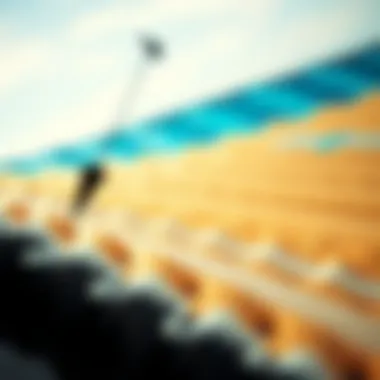
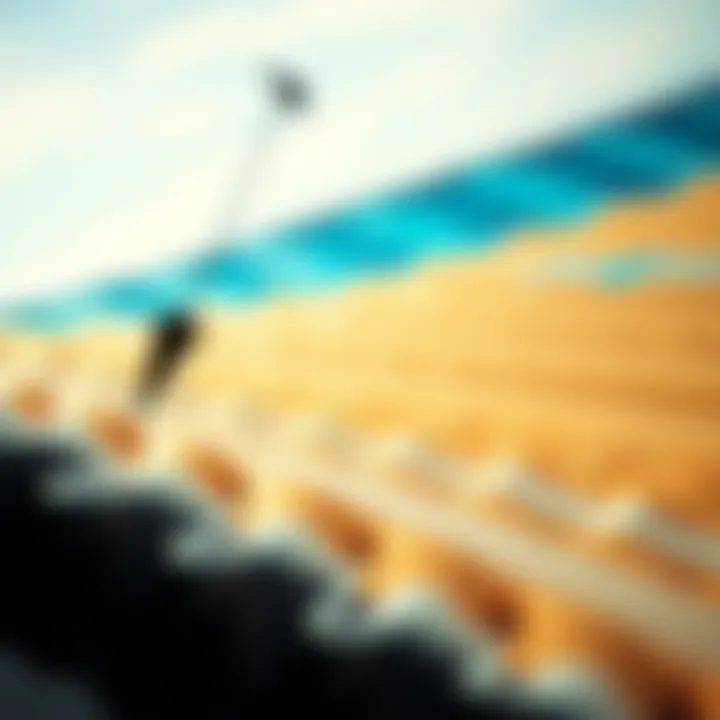
Understanding the benefits of these materials can help riders determine which inflatable kite wing suits their needs best, particularly for conditions they often face.
Structure and Aerodynamics
The structure of an inflatable kite wing is a feat of engineering that greatly influences its aerodynamic capabilities. Typically, a kite is designed with several chambers that can be inflated with air, shaping the wing into a streamlined form that maximizes lift. This design is essential for achieving optimal performance during a session.
Key structural components include:
- Leading Edge: This is the front part of the wing that first meets the wind. A well-designed leading edge ensures that airflow remains smooth around the kite, decreasing drag and enhancing lift.
- Struts: These are the supports that maintain the kite's shape. The number and positioning of the struts can significantly affect stability and responsiveness. A three-strut design, for instance, offers a balance between performance and stability, while a five-strut setup may provide more rigidity, favoring freestyle maneuvers.
In terms of aerodynamics, the shape and curvature of the kite are vital. A flatter profile yields quicker speed but may sacrifice lift, while a more rounded design provides better lift but could reduce top-end speed. Riders often align their preferences with the shape of the kite to suit their riding style, whether for freestyle, wave riding, or racing.
"The sweet spot in kite design lies at the intersection of performance, durability, and usability, which is why ongoing innovations in materials and aerodynamics continue to evolve."
In summary, the design and construction of inflatable kite wings combine advanced materials with engineered structures to create responsive, high-performance wings tailored for diverse riding environments. Riders who grasp these concepts can make informed decisions that align with their specific needs and enhance their kiteboarding experiences. For more in-depth information on kite wing construction and technology, consider checking out resources such as Wikipedia and Britannica.
Faithful maintenance of these materials and structure can culminate in a kite wing that performs resonantly well, ultimately translating into unforgettable experiences on the water.
Performance Characteristics
The performance characteristics of inflatable kite wings are pivotal in determining how a rider experiences the thrill of kiteboarding. These characteristics encompass lift, stability, handling, control, wind range, and responsiveness. By understanding these elements, riders can make informed decisions that enhance their performance on the water and maximize enjoyment during their sessions. A kite's performance isn't just about speed; it's about how efficiently it interacts with the air and how the rider can manipulate it. Let's explore each of these aspects in detail to see how they come together to shape an unforgettable kiteboarding experience.
Lift and Stability
Lift is the force that elevates the kite into the air, and it plays a crucial role in the overall performance of inflatable kite wings. A well-designed kite can generate significant lift without requiring excessive wind speed, allowing riders to harness their full potential in varied conditions. When the kite is properly powered, it gives riders the exhilarating ability to pop off the water during jumps or easily cruise across the waves.
Stability goes hand in hand with lift. A stable wing is less likely to flutter and stall, providing a smoother ride. This is particularly advantageous for beginners who may still be honing their skills. Here are a few points to consider:
- Wing Shape: A higher aspect ratio typically enhances lift and stability, making it easier for riders to maintain their altitude.
- Bridle Configuration: The arrangement of lines on the kite can significantly affect stability, particularly in gusty winds.
- Weight Distribution: An even weight distribution across the wing prevents it from becoming too twitchy, offering a more forgiving ride.
"A stable kite lets you focus on your maneuvers rather than fiddling with control lines amidst unpredictable gusts."
Handling and Control
Handling and control are the bread and butter of kiteboarding. The ability to steer the kite smoothly without excessive effort is what allows riders to perform intricate moves or simply stay on course. Effective handling is produced by a combination of the kite's design and the rider's input. Key factors include:
- Turn Responsiveness: A kite should turn on a dime without sacrificing speed. The use of a smaller leading edge or a more agile bridle configuration can aid in achieving this.
- Input Sensitivity: Some kites react almost instantly to rider input, which is great for advanced techniques, while others are designed for a more progressive steering response, suitable for beginners.
- Weight and Balance: Lighter kites can be easier to maneuver, but stability should remain a priority to ensure control under various conditions.
Wind Range and Responsiveness
A kite's wind range and responsiveness indicate how well it performs across different wind conditions. A kite with a wide wind range can adapt to breezy days as well as lighter winds, making it versatile for various riders and locations. In addition:
- Power Management: A kite that remains responsive even at the edges of its wind range helps riders maintain control without getting overpowered.
- Gust Handling: Some kites excel at absorbing gusts without losing lift, contributing to a more enjoyable ride. Look for features like flexible wingtips that help in navigating wind fluctuations.
- Feedback Mechanism: Good communication from the kite to the rider allows for quicker adjustments, essential for safe riding and executing complex maneuvers.
Choosing the right inflatable kite wing greatly affects how effectively a rider can navigate varying conditions, maximizing both fun and performance on the water. Understanding lift and stability, handling and control, and wind range and responsiveness empowers kiteboarders to select kites tailored to their specific needs, enhancing their time on the water while promoting safety and skill development.
Choosing the Right Inflatable Kite Wing
Choosing the right inflatable kite wing is akin to finding the right pair of shoes before a long walk; it makes all the difference. With the expansive variety of kite wings available, selecting the one that suits your riding style, conditions, and personal preferences is crucial for an optimal kiteboarding experience. Right choices can enhance performance, increase safety, and boost overall enjoyment on the water, making this a vital aspect to consider for both novice and seasoned riders alike.
Rider Experience and Skill Level
It's essential to match your skill level with the appropriate inflatable kite wing. Beginners may benefit from wings that provide greater stability and ease of control. These often feature design elements that help lift even in lighter winds. Conversely, for more experienced kiteboarders, performance-oriented wings that prioritize speed and maneuverability might be more suitable.
The importance of this consideration lies in understanding how varying experience levels can impact handling and responsiveness. A more seasoned rider may have the necessary skills to manage a sophisticated wing that demands precise techniques, while a newbie could easily become overwhelmed.
Key aspects to consider:
- Designed for Beginners: Wings that offer a stable platform, are soft in handling, and have larger surface areas.
- Intermediate Choices: Balances stability with some performance features; a mix that aids both skills growth and fun.
- Advanced Options: High aspect ratio wings with less pull, designed for those seeking speed and aerial tricks.
"The kite wing you choose can be a game-changer—like choosing between a comfy old t-shirt and a tailored suit for an important occasion."
Size Selection
The size of the inflatable kite wing is not just a matter of personal preference; it plays a pivotal role in determining performance characteristics such as lift and control. The size directly correlates with the wind conditions and the weight of the kiteboarder. A larger wing catches more wind, making it excellent for lighter breezes; however, in strong winds, such a wing could become cumbersome and difficult to control.
For optimal performance, riders should carefully assess several factors when selecting size:
- Rider Weight: Heavier riders may need larger wings to generate adequate lift, while lighter riders can often opt for smaller wings.
- Wind Strength: Stronger winds typically call for smaller wings to maintain manageable speeds and control.
- Skill Level: As riders become more proficient, they might experiment with smaller wings for agility and speed.
Kiteboarding Conditions
Environmental conditions play a significant role in kite wing selection. Locations with consistently strong winds can allow for different design choices compared to areas where winds are more erratic. Factors such as water type—flat water, choppy seas, or waves—also influence choice.
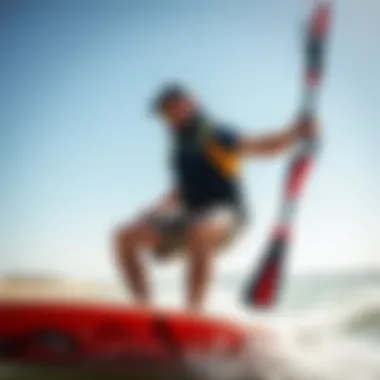
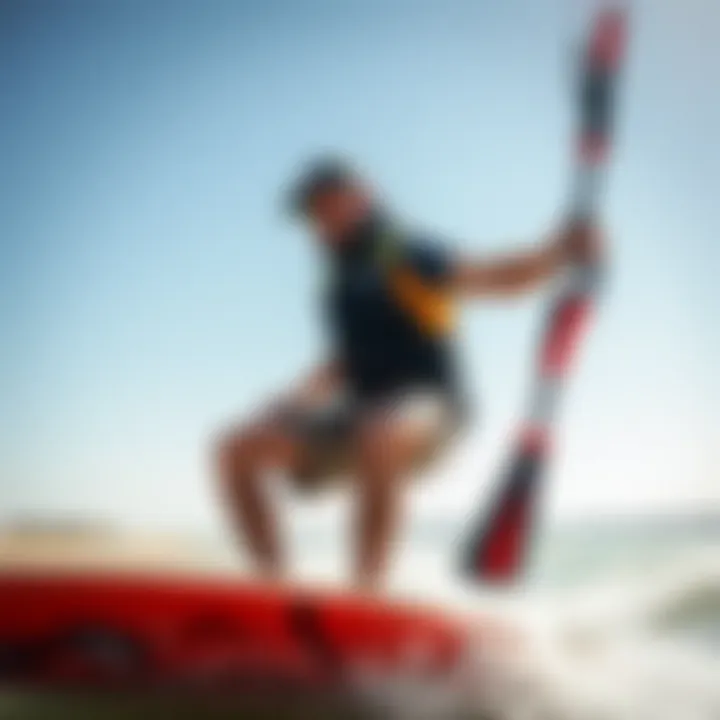
- Flat Water: Perfect for big wings; they help generate lift easily, allowing for a smooth ride.
- Choppy Conditions: Opt for wings with a higher aspect ratio—these allow for better control and less drag, making the ride more enjoyable.
- Waves: Riders might prefer wings that offer quicker turning capabilities for maneuvering the surf.
Kiteboarding Techniques with Inflatable Wings
Kiteboarding has become a dynamic sport that combines elements of surfing and flying, offering a thrilling experience that captivates many enthusiasts. Inflatable kite wings, with their capability to harness wind power efficiently, have unlocked new avenues for both novice and seasoned riders. This section delves into the importance of mastering various kiteboarding techniques specific to inflatable wings, as they significantly enhance control, performance, and overall enjoyment while riding.
Being familiar with different techniques not only increases one's skill set but also contributes to safety on the water. Emphasizing precision in maneuvers can make a noticeable difference in one’s performance, impacting everything from speed to stability.
Basic Maneuvers
Learning basic maneuvers is crucial for any kiteboarder using inflatable wings. These foundational techniques lay the groundwork for more advanced tricks and the ability to navigate diverse conditions.
- Water Start: The water start is the first step in getting up and riding. It involves lying on your board in the water, steering the kite to catch the wind at the right angle, and gradually pulling yourself up to a standing position. Proper timing is key.
- Riding Upwind: This technique is about angle management. To ride upwind efficiently, kiteboarders should position their kite higher in the wind window, allowing them to make progress against the wind. This skill enhances your time on the water and minimizes the need for excessive downwind travel.
- Turning (Tacking and Gybing): Mastering turns is essential for changing direction. Tacking involves turning the board into the wind, while gybing is turning with the wind. Each technique requires a shift in body weight and precise control of the kite.
- Jumping: Once comfortable with the basics, jumping becomes an exhilarating option. Timing the pull on the bar as you edge downwind allows you to generate lift. Remember, perfecting your landing is just as important as the jump itself.
Practicing these maneuvers builds confidence, enabling riders to enjoy longer sessions while minimizing frustrations and risks.
Advanced Techniques
Advanced techniques require a higher level of skill and understanding of inflatable kite wings. Riders can take their abilities to the next level by incorporating more complex movements and tricks into their repertoire. Below are a few advanced techniques:
- Backrolls and Frontrolls: These aerial tricks involve rotating your body while airborne. Initiating a backroll requires looking over your shoulder and committing to the rotation as you take flight. Frontrolls require similar body dynamics but in the opposite direction. Mastering these moves takes time and practice.
- Kiteloops: One of the most adrenaline-pumping tricks, kiteloops, involves steering the kite dramatically while in the air to create a loop. This generates a powerful pull as the kite drags you through the air, demanding precise control and timing.
- Shifting Weight in the Air: Riders can execute a variety of tricks by shifting their weight while airborne. By leaning into or pulling away from the edge of the board, kiteboarders can perform spins or even transitions mid-air.
- Double Jumps: Some riders manage a double jump by timing their descent with a kite loop. The key is to prepare early, ensuring that the kite is positioned correctly for a successful second jump. This trick requires ample navigation experience and air awareness.
Learning these advanced maneuvers open new horizons for creativity on the water. The combination of physical skills, mental preparation, and awareness contributes to a more enriched kiteboarding experience.
"Practice doesn't make perfect. Practice makes progress."
Mastering various kiteboarding techniques with inflatable wings is indispensable for all riders. Whether you’re just getting a feel of the wind or showcasing gravity-defying jumps, diligence in learning these skills will greatly enhance your kiteboarding journey.
Maintenance and Care
In the world of kiteboarding, the performance of inflatable kite wings can significantly depend on how they're maintained and cared for. Just like any other piece of sporting equipment, your kite wing requires attention to ensure it stays in good condition. This attention can elevate your riding experience while prolonging the lifespan of your gear. It’s not just about having the latest model; it’s about keeping it in peak performance consistently.
The care routines for inflatable kite wings often relate to two main areas: proper storage and the ability to repair minor damages. Having a clear understanding of these factors can be game-changing, especially for those who spend a lot of time on the water.
Proper Storage
When it comes to storing kite wings, the environment plays a crucial role. You want to avoid extreme heat or cold, as both can warp the materials, causing performance issues or even irreparable damage. Ideally, store your kite wing in a dry, cool place, away from direct sunlight to prevent UV degradation.
- Clean First: Before putting your kite away, it’s essential to clean off sand, salt, and any grime. The best way is to rinse it with fresh water and leave it to dry completely. A damp kite stored away can lead to mold, which is far from ideal.
- Use a Protective Bag: Consider using a dedicated kite bag. This doesn’t just keep it safe from scratches; it can also offer a bit of additional padding against knocks.
- Avoid Folding: Instead of folding your kite, roll it. This minimizes creases in the fabric, which can lead to weak spots over time.
Ultimately, proper storage ensures that your inflatable kite wing is ready to perform when you are.
Repairing Minor Damages
Even the most seasoned kiteboarders encounter minor damages. Whether it’s a small tear or a puncture from an unexpected encounter with a sharp object, knowing how to address these efficiently can save your day on the water.
- Basic Repair Kit: Always have a basic repair kit handy. This should include self-adhesive patches, a roller for compacting the patches, and some tear aid. The quicker you can make a repair, the less likely it is to worsen.
- Follow Patching Instructions: When applying a patch, ensure the area is clean and dry. Apply the patch over the damage, applying pressure for a few minutes. A good rule of thumb is to let the patch cure for several hours before taking to the water, allowing it to bond properly.
- Visual Inspections: Regularly check your kite for signs of wear. Catching minor issues early can prevent them from becoming major repairs down the line.
Taking the time to properly care for and maintain your inflatable kite wing will pay dividends, enhancing your kiteboarding experience. As you become more vigilant with these routines, you’ll find that your gear has a much longer lifespan, ensuring countless adventures on the water to come.
"A well-cared kite is more than just gear; it's your partner in conquering the waves."
For more in-depth knowledge on kite maintenance, you can visit resources like Wikipedia on Kiteboarding or British Kite Sports Association.
Consider diving into community forums, such as Reddit's Kiteboarding Community for shared experiences and tips from fellow enthusiasts.
Trends in Inflatable Kite Wing Technology
The kiteboarding scene is not just about flying over the waves; it’s also about keeping up with the latest trends in technology surrounding inflatable kite wings. The advances in this area are profound and essential for anyone who wishes to get a grip on the sport. As kiteboarding continues to capture hearts and minds, it’s clear the technology behind inflatable kite wings is rapidly evolving. Understanding these trends can equip both novice and experienced riders with the knowledge they need to optimize their experiences.
Innovations in Materials
Inflatable kite wings depend heavily on the materials used in their construction. Traditionally, these wings were made from heavy fabrics that could limit performance. However, we’re seeing a shift towards lighter and stronger materials, such as ripstop nylon and polyester blends, which enhance durability without adding weight. Some manufacturers have started incorporating advanced composites, which offer both resilience and flexibility, characteristics that seem tailor-made for kiteboarding.
- Ultra-light materials: The rise of lightweight fabrics allows for better lift and responsiveness during maneuvers.
- Durability enhancements: New coatings and treatments extend the lifespan of kite wings considerably, making them resistant to UV rays and saltwater.
- Eco-friendly options: As environmental concerns grow, some brands are turning to sustainable materials, cuttng down on environmental impact.
These innovations don’t just improve performance; they also affect accessibility. For instance, lighter wings make it easier for beginners to handle the equipment, while advanced riders benefit from improved performance on the water.
Enhancements in Design
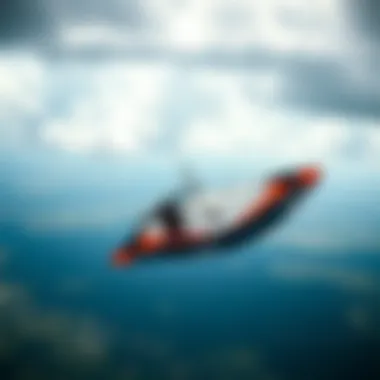
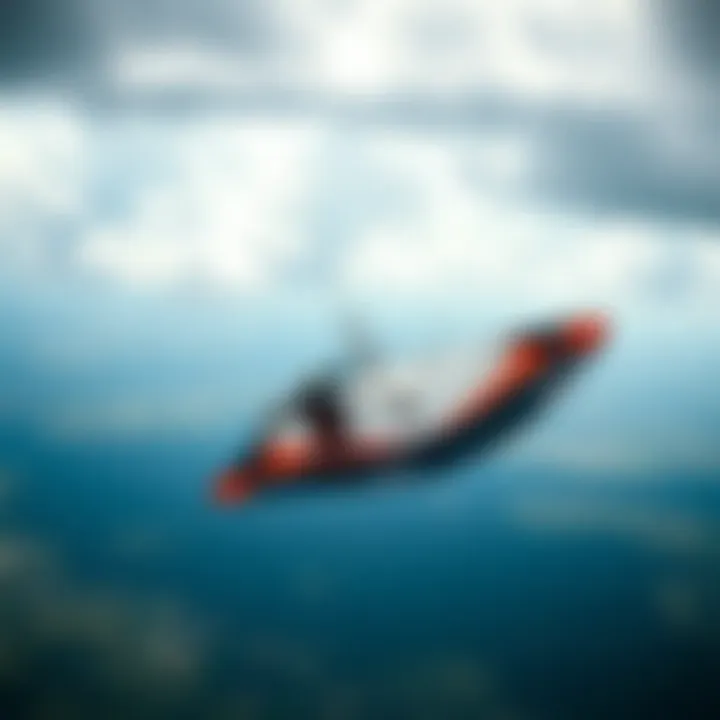
The design of inflatable kite wings has come a long way, influenced by both technological advances and rider feedback. Modern wings are no longer just a matter of functional aesthetics; they incorporate engineering principles to improve overall performance. Here are some crucial factors in current design trends:
- Shape and Profile: Today's wings feature more refined shapes, such as high-aspect-ratio designs, which allow for greater speed and efficiency across various wind conditions.
- Inflation Systems: Quick inflation and deflation systems are becoming standard, making the setup process quicker and easier for riders, which is especially beneficial in changing conditions.
- Adjustable Features: Many wings now include adjustable settings that allow customization of traits like stiffness and flexibility, enabling riders to tailor performance to their preferences or the current conditions.
These improvements in design not only enhance performance but make kiteboarding more enjoyable. Riders are now able to make the most out of every breeze without being constrained by outdated technology.
The combination of innovative materials and cutting-edge design is effectively shaping the future of kiteboarding, making it more approachable and exciting for all riders.
Environmental Considerations
When it comes to understanding the landscape of inflatable kite wings, environmental considerations play an integral role. As the kiteboarding community grows, so does the importance of sustainability and the impact of these sports on our natural surroundings. It’s crucial to grasp not just the fun and thrilling aspects of kiteboarding, but also to recognize the responsibility that comes with it. Careful attention to the environmental implications can enhance the experience of kiteboarding while preserving the beautiful environments that provide us with the thrills.
Sustainability in Kiteboarding
Sustainability in kiteboarding centers around using eco-friendly materials and practices that minimize environmental harm. This notion is gaining traction as manufacturers craft inflatable wings from recycled materials, significantly reducing their ecological footprint. For example, companies like Slingshot and Ozone have initiated projects that focus on sustainability, investing in eco-friendly production processes and materials. Here are a few key points regarding sustainability in kiteboarding:
- Material Innovation: The kiteboarding industry is slowly shifting to more sustainable materials. For instance, the use of recycled polyester and biodegradable fabrics is becoming more common.
- Durability vs. Waste: High-quality inflatable wings not only perform better but also last longer. This reduces waste significantly, as a single kite can serve many seasons if properly maintained, lessening the need for continuous replacements.
- Eco-Friendly Practices: From production to use, incorporating eco-friendly practices in kiteboarding, such as taking care of local environments and participating in beach clean-ups, can enhance the sport’s image.
As a kiteboarder, conscious choices in equipment and practices contribute to a cleaner, greener future while enjoying your time on the water.
Impact on Natural Environments
The footprint of kiteboarding extends beyond the sport itself; it encompasses the essence of nature that so many enthusiasts cherish. Understanding how inflatable kite wings can affect natural environments is vital for every rider. Recognizing both positive and negative impacts helps promote responsible practices among the community. Some key impacts include:
- Wildlife Disturbance: Kiteboarding can disturb local wildlife, especially in populated coastal areas. Being aware of nesting sites and avoiding sensitive habitats during certain seasons can help mitigate this issue.
- Erosion and Habitat Damage: Repeated use of the same launch and landing spots can lead to erosion and habitat damage. To counteract this, selecting different areas or rotating use across a more extensive beach can help.
- Pollution: While out riding, it’s important to remember that our actions affect the local ecosystem. Leaving no trace by packing out whatever you bring in and encouraging fellow riders to do the same is essential for minimizing pollution.
"Every time you enjoy a wave or a breeze, remember that the sport you love relies on the health of our natural environments; it’s up to us to keep them alive and vibrant."
As kiteboarders, we have a duty not only to enjoy our sport but also to protect the environments that make it possible. By fostering sustainable practices and being mindful of our impact, we can ensure that future generations enjoy the same thrills that we do today.
For more about sustainable practices in water sports and their benefits, you may refer to resources on sustainability from Wikipedia and communities discussing eco-conscious activities on forums like Reddit.
By integrating these environmental considerations into our kiteboarding lifestyle, we can enjoy the sport while nurturing the balance of nature around us.
Community Insights and Testimonials
When it comes to inflatable kite wings, listening to firsthand experiences can truly illuminate the ins and outs of this thrilling sport. The kiteboarding community is a melting pot of enthusiasts ranging from beginners to seasoned experts. By tapping into these insights, readers can grasp the real-world implications of different kite wing technologies and designs.
Rider testimonials serve as a treasure trove of information, highlighting what to expect on the water, along with practical tips that might not find their way into traditional instructional materials. Riders share stories of triumphs and tribulations—moments where equipment either made or broke their experience, all adding layers to a broader understanding of what inflatable kite wings bring to the table.
Rider Experiences
Rider experiences dive deep into personal narratives that many can relate to. These accounts often reflect the trials—like learning to control the wing on a blustery day or adapting techniques based on variable wind conditions. For example, one rider might recount an afternoon spent battling strong gusts and learning the hard way about the importance of adjusting the wing size for optimal performance. The shared wisdom resonates broadly, helping newcomers avoid pitfalls that seasoned kiteboarders have already navigated.
Moreover, attending community-focused events, like kiteboarding festivals or competitions, provides an excellent bedrock for these stories. Here, riders not only showcase their skills but also discuss the nuances of their equipment. Feedback from peers during these gatherings can greatly influence purchasing decisions. A rider reflecting on which inflatable kite wing offered the best stability might lead others towards brands like Ozone or SlingShot, illustrating how community experiences shape the decision-making process.
Instructor Perspectives
Instructors, possessing a bird's eye view of many riders' journeys, offer invaluable insights steeped in experience. Their perspectives bridge the gap between technical knowledge and practical application. For instance, instructors often observe common mistakes made by beginners, emphasizing the importance of choosing the right wing for a rider's skill level and environmental conditions.
An experienced instructor might highlight how certain kite wings perform in diverse conditions, providing potential riders guidance before they hit the water. They tell tales of students struggling with control in certain winds, and how switching to a more stable wing made all the difference. This way, instructors become the voices of reason, helping riders avoid the typical "trial and error" phase.
Furthermore, instructors are at the forefront of innovations in the field. They might share thoughts on recent advancements in materials and design, gleaning insights from direct interactions with brands. This knowledge can advise potential buyers that, for instance, a new wing made from a lighter fabric could deliver a noticeable advantage in performance.
The affair between the kiteboarding community and its experts fosters a rich environment for learning and growth. Whether sharing their experiences or dissecting the finer points of inflatable kite wings, these individuals create a vibrant dialog that enhances everyone's understanding and appreciation of this exciting sport.
Future Directions in Kiteboarding
As kiteboarding continues to grow and evolve, it’s vital to look ahead at what the future may hold for those who ride the wind. The future directions in kiteboarding are not just about innovation; they're also about enhancing the experience, accessibility, and sustainability of this exhilarating sport. We’ll explore emerging markets and make predictions on how kite wing design might transform.
Emerging Markets for Kiteboarding
With the global interest in water sports surging, emerging markets for kiteboarding are becoming increasingly significant. Countries that previously didn’t have a vibrant kiteboarding community are starting to open their shores to enthusiasts.
- Southeast Asia: Regions like Thailand and Vietnam are witnessing an influx of tourists looking for kiteboarding experiences. The warm, consistent winds paired with stunning landscapes make for perfect conditions.
- South America: Countries such as Brazil, with its vast coastline and annual wind patterns, are also becoming hotspots for kiteboarders. As the local community grows, it encourages more international events.
- Africa: Coastal nations like Morocco and South Africa are drawing attention for their unique spots. The blend of culture and thrill creates a unique kiteboarding journey for riders.
As awareness of kiteboarding deepens, educational programs and local instructors are crucial in facilitating access and sustaining interest in these new markets. Furthermore, these markets can adapt existing knowledge with local conditions, benefiting both beginners and advanced riders.
Predictions for Kite Wing Design
Kite wing design has come a long way, but it is safe to say we’ve only scratched the surface. As materials and technology improve, we can anticipate significant advancements in the specifications and functionalities of inflatable kite wings.
- Lightweight Materials: Future kite wings will likely incorporate even lighter materials that maintain durability while enhancing portability. This would address previous challenges related to transportation, allowing riders to travel more freely with their gear.
- Smart Technology Integration: Imagine incorporating smart sensors in kite wings, providing real-time data on wind conditions, performance metrics, and even rider feedback. Riding with technology could ultimately make kiteboarding safer and more enjoyable.
- Customization Options: Increased consumer interest might lead manufacturers to offer more customizable options for kite wings. Riders could tailor sizes, shapes, and color schemes to fit their personal preferences and riding styles, resulting in a more intimate connection to their gear.
Advancements do not come without consideration. As designs evolve, ensuring that these innovations remain accessible to all riders—regardless of skill or budget—will be essential.
The future holds great promise for kiteboarding, where inclusivity and technology will redefine how we interact with the wind and water.







